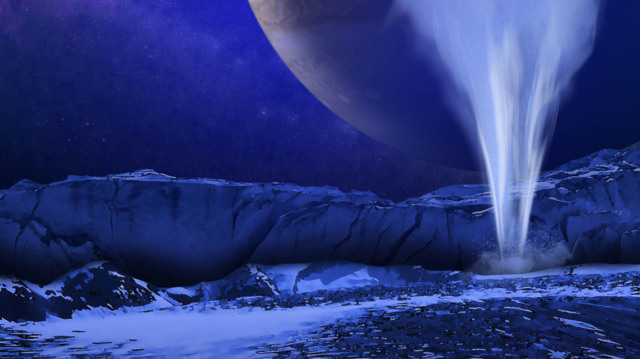Confirmed: Jupiter’s moon Europa has water geysers. Fucking WATER GEYSERS, friends!

Oh, hell yeah. Jupiter’s moon Europa? That motherfucker? It’s got actual water geysers. Confirmed. It had been suspected, but now we know. And, fuck, let’s get out there ASAP.
NASA:
Forty years ago, a Voyager spacecraft snapped the first closeup images of Europa, one of Jupiter’s 79 moons. These revealed brownish cracks slicing the moon’s icy surface, which give Europa the look of a veiny eyeball. Missions to the outer solar system in the decades since have amassed enough additional information about Europa to make it a high-priority target of investigation in NASA’s search for life.
What makes this moon so alluring is the possibility that it may possess all of the ingredients necessary for life. Scientists have evidence that one of these ingredients, liquid water, is present under the icy surface and may sometimes erupt into space in huge geysers. But no one has been able to confirm the presence of water in these plumes by directly measuring the water molecule itself. Now, an international research team led out of NASA’s Goddard Space Flight Center in Greenbelt, Maryland, has detected the water vapor for the first time above Europa’s surface. The team measured the vapor by peering at Europa through one of the world’s biggest telescopes in Hawaii.
Confirming that water vapor is present above Europa helps scientists better understand the inner workings of the moon. For example, it helps support an idea, of which scientists are confident, that there’s a liquid water ocean, possibly twice as big as Earth’s, sloshing beneath this moon’s miles-thick ice shell. Another source of water for the plumes, some scientists suspect, could be shallow reservoirs of melted water ice not far below Europa’s surface. It’s also possible that Jupiter’s strong radiation field is stripping water particles from Europa’s ice shell, though the recent investigation argued against this mechanism as the source of the observed water.
“Essential chemical elements (carbon, hydrogen, oxygen, nitrogen, phosphorus, and sulfur) and sources of energy, two of three requirements for life, are found all over the solar system. But the third — liquid water — is somewhat hard to find beyond Earth,” said Lucas Paganini, a NASA planetary scientist who led the water detection investigation. “While scientists have not yet detected liquid water directly, we’ve found the next best thing: water in vapor form.”
Paganini and his team reported in the journal Nature Astronomy on November 18 that they detected enough water releasing from Europa (5,202 pounds, or 2,360 kilograms, per second) to fill an Olympic-size swimming pool within minutes. Yet, the scientists also found that the water appears infrequently, at least in amounts large enough to detect from Earth, said Paganini: “For me, the interesting thing about this work is not only the first direct detection of water above Europa, but also the lack thereof within the limits of our detection method.”
Animation of water molecules at Europa
Water molecules emit specific frequencies of infrared light as they interact with solar radiation.
Credits: Michael Lentz/NASA Goddard
Indeed, Paganini’s team detected the faint yet distinct signal of water vapor just once throughout 17 nights of observations between 2016 and 2017. Looking at the moon from the W. M. Keck Observatory atop the dormant Mauna Kea volcano in Hawaii, the scientists saw water molecules at Europa’s leading hemisphere, or the side of the moon that’s always facing in the direction of the moon’s orbit around Jupiter. (Europa, like Earth’s moon, is gravitationally locked to its host planet, so the leading hemisphere always faces the direction of the orbit, while the trailing hemisphere always faces in the opposite direction.)They used a spectrograph at the Keck Observatory that measures the chemical composition of planetary atmospheres through the infrared light they emit or absorb. Molecules such as water emit specific frequencies of infrared light as they interact with solar radiation.



